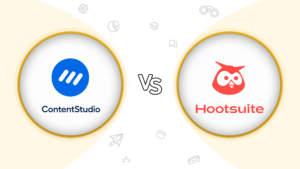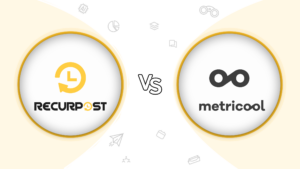Buffer vs SocialPilot
Buffer vs Socialpilot – What’s Better For You in 2025?
Which tool is the best? Is it that hard to decide?
If you're stuck between Buffer and SocialPilot, you're not alone. Both offer great features, but the right choice depends on your needs.
No credit card required

Quick Summary: Buffer and SocialPilot
When deciding on the perfect social media management tool, certain aspects, such as features, pricing, reviews, and support, must be evaluated.
Here is the overview of tools:
2 months free with annual billing
Buffer empowers social media managers and digital marketers to plan, schedule, and publish content with ease. Trusted by over 57,000 paying customers, Buffer’s intuitive dashboard streamlines multi-platform posting so you spend less time juggling accounts and more time crafting engaging campaigns.
Whether you’re coordinating a brand’s monthly calendar or rolling out real-time promotions, Buffer keeps your workflow organized and your audience engaged, all while providing transparent metrics to track your progress.
Capterra users highlight Buffer’s ease of use, content queueing, and dependable posting. It’s seen as beginner-friendly. Downsides include limited collaboration tools and advanced analytics compared to enterprise platforms. [Capterra]
Users praise Buffer’s clean interface, simplicity, and reliable scheduling across multiple platforms. Analytics and link tracking are valued. Some reviews note limited advanced features compared to bigger competitors. [G2]
SocialPilot
SocialPilot, serves agencies and in-house teams seeking a robust yet user-friendly social media suite. With more than 250,000 users worldwide, it unifies content scheduling, bulk publishing, and client collaboration in one portal.
Social media managers appreciate its clean interface and analytic snapshots, which simplify reporting and elevate strategic decision-making. From small businesses to large marketing firms, SocialPilot scales to meet diverse needs without overwhelming marketers with jargon.
Reviews on Capterra celebrate SocialPilot’s team collaboration, budget pricing, and straightforward dashboard. Bulk posting saves time. Minor criticisms involve restricted automation features, but overall satisfaction is consistently high among users. [Capterra]
SocialPilot reviews emphasize affordability, bulk scheduling, and white-label reports. Agencies love its client management features. Some mention missing deeper integrations, but most consider it a cost-effective alternative to expensive tools. [G2]
Rating Comparison
Feature Comparison: Buffer vs SocialPilot
Features
Scheduling & Publishing
Queue-based scheduling with visual calendar; supports Instagram, Threads, TikTok, and more.
Bulk scheduling, queue slots, and platform-specific posting from a visual calendar dashboard.
AI-powered scheduler recycles evergreen content, auto-schedules posts, and suggests best times to publish.
Engagement
Simple inbox to reply to comments and messages on Instagram and Facebook.
Social inbox with message filtering and direct replies for Facebook, LinkedIn, and Instagram.
Unified inbox helps reply faster; smart filters prioritize conversations that need attention.
Collaboration
Team roles, post approvals, and shared calendars for streamlined content workflows.
Supports team workflows with role-based access, content approvals, and client management.
Shared workspaces and approval flows keep teams aligned with role-based access and smart task routing.
Analytics
Track engagement, clicks, reach, and top posts with platform-specific insights.
Downloadable, white-label reports with detailed performance insights and engagement metrics.
Smart analytics track engagement, reach, and clicks; white-label reports simplify client performance tracking.
AI Features
AI Assistant writes captions, improves tone, suggests hashtags, and identifies ideal post times.
AI Assistant generates captions, suggests hashtags, and highlights best posting times per platform.
Generates captions, hashtags, bios, and post ideas; predicts performance; automates scheduling and reports.
Pros & Cons: Buffer and SocialPilot
Pros
- Simple and intuitive interface.
- Ideal for small businesses and individual users.
Cons
- Lacks advanced social listening features.
- Limited reporting capabilities for multi-platform comparison.
Pros
- Supports a wide range of social media platforms.
- Advanced analytics and reporting features.
Cons
- The user interface can be overwhelming for new users.
- More expensive than Buffer for basic plans.
Pricing Comparison
Free
3 Social channels, 10 scheduled posts per channel, Best Time to Post
Essential
7 Social Media Accounts, 1 User 500 AI Credits
Starter
2 social profiles, 10 daily posts, 5 recurring time slots
Essentials
5 Social channels, 1 user account, Best Time to Post
Standard
15 Social Media Accounts, 3 Users, 1000 AI Credits
Personal
5 social profiles, 20 daily posts, 10 recurring time slots
Team
5 Social channels, Unlimited user accounts, Best Time to Post
Premium
25 Social Media Accounts, 6 Users, 5000 AI Credits
Agency
20 social profiles, 80 daily posts, 40 recurring time slots
Why RecurPost Stands Out
RecurPost is the ultimate all-in-one social media management tool designed to save time and maximize impact. For those who compare Buffer vs SocialPilot, RecurPost often emerges as a smarter choice thanks to its intelligent automation and ease of use. While debates about the cost of Buffer and SocialPilot are common, RecurPost provides excellent value without unnecessary complexity.
Its bulk scheduling lets you upload and schedule multiple posts at once, while intelligent recycling ensures your top content keeps working for you. The SocialPilot scheduler is often mentioned in reviews, but RecurPost takes scheduling further with RSS imports, Instagram DM automation, and even automated first comments.
An intuitive shared calendar and drag-and-drop drafts make planning effortless, while creative extras like seasonal libraries, dynamic placeholders, and a visual Instagram grid planner enhance your brand consistency. RecurPost also supports agencies with white-label analytics, client-ready reports, and an agency pricing calculator.
When people explore SocialPilot social media reviews or compare Buffer to other platforms, RecurPost consistently stands out. With free templates, built-in royalty-free image libraries, and AI-powered generators, it’s a complete toolkit that empowers businesses to save time, boost engagement, and grow seamlessly.
Why RecurPost is better!
RecurPost isn’t just an alternative to Buffer and SocialPilot – it’s a smarter choice for businesses that want more functionality at a lower cost.






